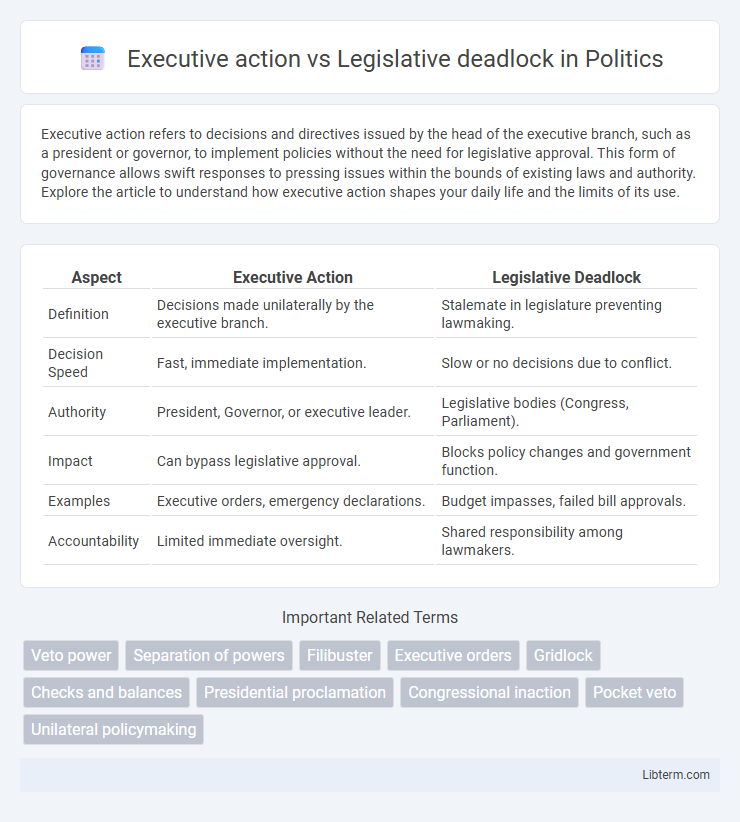Executive action refers to decisions and directives issued by the head of the executive branch, such as a president or governor, to implement policies without the need for legislative approval. This form of governance allows swift responses to pressing issues within the bounds of existing laws and authority. Explore the article to understand how executive action shapes your daily life and the limits of its use.
Table of Comparison
| Aspect | Executive Action | Legislative Deadlock |
|---|---|---|
| Definition | Decisions made unilaterally by the executive branch. | Stalemate in legislature preventing lawmaking. |
| Decision Speed | Fast, immediate implementation. | Slow or no decisions due to conflict. |
| Authority | President, Governor, or executive leader. | Legislative bodies (Congress, Parliament). |
| Impact | Can bypass legislative approval. | Blocks policy changes and government function. |
| Examples | Executive orders, emergency declarations. | Budget impasses, failed bill approvals. |
| Accountability | Limited immediate oversight. | Shared responsibility among lawmakers. |
Understanding Executive Action: Powers and Limits
Executive action enables the President to implement policies quickly through orders and directives, bypassing legislative gridlock. These powers include issuing executive orders, managing federal agencies, and directing national security measures, yet they are constrained by judicial review, Congressional oversight, and constitutional limits. Understanding these checks and balances is essential to assessing the effectiveness and boundaries of executive authority during legislative deadlock.
What Causes Legislative Deadlock?
Legislative deadlock often results from deep partisan divisions within a bicameral legislature, where conflicting party majorities in the House and Senate impede consensus on key policies. Complex policy issues combined with ideological polarization create gridlock by fostering inflexible stances among lawmakers. Procedural rules like filibusters or supermajority voting requirements further exacerbate stalemates, prompting executives to bypass deadlock through unilateral actions such as executive orders.
Historical Examples of Executive Action in Times of Gridlock
During periods of legislative deadlock, presidents have frequently resorted to executive actions to advance policy goals, exemplified by Franklin D. Roosevelt's New Deal programs during the 1930s Great Depression and Barack Obama's executive orders on immigration reform amid Congressional stalemates. These instances demonstrate how executive authority can be employed to bypass gridlocked legislatures and implement critical social and economic reforms swiftly. Historical patterns show that executive action becomes a pivotal tool for governance when partisan divisions prevent legislative consensus.
Legal Boundaries: Executive Orders vs. Legislation
Executive action through executive orders allows the president to implement policies swiftly within the scope defined by existing statutes and the Constitution. Legislative deadlock occurs when Congress fails to pass laws due to partisan disagreements, limiting formal legislative responses to policy issues. Legal boundaries for executive orders are constrained by federal law and judicial review, preventing executives from creating new laws beyond statutory authority, whereas legislation passed by Congress holds broader legal weight and permanence.
Impact on Policy: Quick Wins or Short-Term Solutions?
Executive action enables rapid policy implementation, bypassing legislative gridlock to address urgent issues with quick wins. However, these short-term solutions may lack durability and face legal challenges, limiting long-term impact. Legislative deadlock slows comprehensive reform but fosters more stable, thoroughly debated policies with broader support.
Congressional Response to Executive Overreach
Congressional response to executive overreach often involves legislative measures such as issuing subpoenas, holding hearings, and passing bills to limit presidential authority. Courts may also become involved, with Congress supporting legal challenges to executive actions that exceed statutory or constitutional boundaries. In instances of legislative deadlock, Congress's ability to check executive power can be constrained, prompting increased reliance on judicial intervention and political negotiation.
The Role of the Judiciary in Executive vs. Legislative Power
The judiciary serves as a crucial arbiter in conflicts between executive action and legislative deadlock, interpreting constitutional boundaries to maintain a balance of power. Courts often evaluate executive orders when legislative bodies fail to pass laws, ensuring such actions do not exceed granted authority or violate legal standards. Judicial review safeguards democratic principles by preventing both executive overreach and legislative paralysis from undermining governance.
Public Perception: Accountability and Transparency
Public perception of executive action often centers on concerns about accountability and transparency, as concentrated decision-making can bypass legislative scrutiny. Legislative deadlock, while frustrating, is sometimes viewed as a safeguard that ensures multiple stakeholders are involved in policy formation, promoting transparency through debate. However, prolonged gridlock may erode public trust as it hinders effective governance and visible progress.
Executive Action and Checks & Balances
Executive action allows the president to bypass legislative deadlock by implementing policies through executive orders and directives, providing swift responses to urgent issues. Checks and balances ensure that executive actions are subject to judicial review and Congressional oversight, preventing overreach and maintaining separation of powers. This dynamic reinforces accountability while enabling governance despite paralysis in the legislative branch.
Future Outlook: Breaking the Cycle of Deadlock
Executive action offers a strategic mechanism to bypass legislative deadlock, enabling swift policy implementation in times of political stalemate. Future outlooks emphasize the increasing reliance on executive powers to address urgent issues, though this raises concerns about checks and balances in governance. Advancements in bipartisan negotiation frameworks and digital platforms aim to foster collaboration, potentially breaking the cyclical pattern of legislative gridlock.
Executive action Infographic

 libterm.com
libterm.com